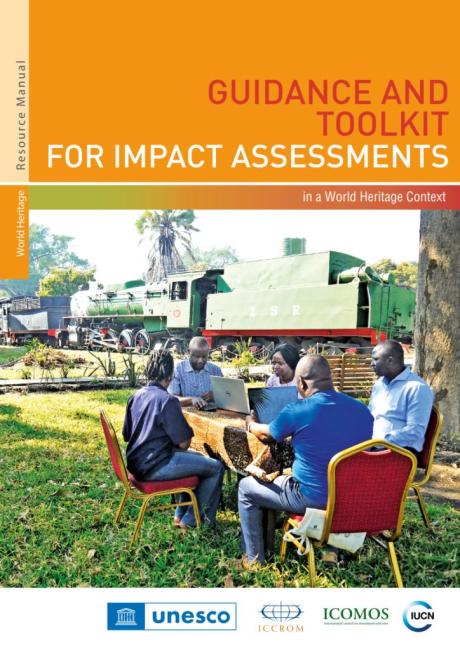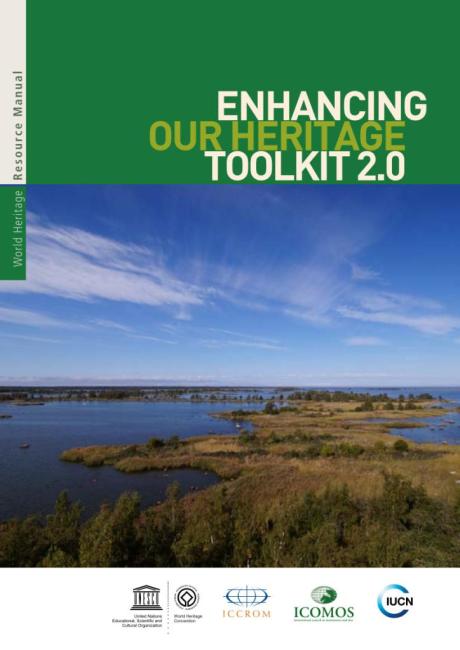Climate action
- Due to its long term and all-pervasive nature, climate change impacts affect many World Heritage All inherited assets which people value for reasons beyond mere utility. Heritage is a broad concept and includes shared legacies from the natural environment, the creations of humans and the creations and interactions between humans and nature. It encompasses built, terrestrial, freshwater and marine environments, landscapes and seascapes, biodiversity, geodiversity, collections, cultural practices, knowledge, living experiences, etc. properties and its multiplier effect in increasing vulnerability to disaster risks requires at-scale system thinking to find innovative and holistic solutions.
- Within DRM, special emphasis is placed on climate change as a hazard due to its fast-moving and all-pervasive nature with global impacts and the multiplier effect.
- World Heritage All inherited assets which people value for reasons beyond mere utility. Heritage is a broad concept and includes shared legacies from the natural environment, the creations of humans and the creations and interactions between humans and nature. It encompasses built, terrestrial, freshwater and marine environments, landscapes and seascapes, biodiversity, geodiversity, collections, cultural practices, knowledge, living experiences, etc. properties, especially natural, mixed and large-scale cultural landscapes, are places that can significantly contribute to climate mitigation by safeguarding natural ecosystems that are carbon sinks and, when feasible and consistent with protecting the OUV, by undertaking actions to enhance carbon sequestration in natural systems.
- Climate adaptation should respond to the hazards that are directly and indirectly influenced by climate change and the exposure of OUV and attributes to these hazards and their related vulnerability (physical, social, economic, institutional, etc.)
- Climate mitigation and adapatation measures should have minimal impact on heritage values including customary land management practices, the livelihoods of Indigenous Peoples and local communities, and be consistent with obligations under the Convention to maintain the OUV above all.
- Climate action refers to efforts taken to combat climate change and its impacts, which include climate change adaptation, climate change mitigation, knowledge-sharing, capacity-building, and raising awareness.
Climate change is one of the most pressing threats for the planet, human societies and, so too, for World Heritage properties and other heritage places. According to the Third Cycle of Periodic Reporting, the fast-moving impacts of climate change are affecting cultural World Heritage properties, for example, exposing heritage structures to extreme weather events, shifting hydrological regimes and/or accelerating the retreat of coastlines. The IUCN World Heritage Outlook periodically assesses the conservation prospects for all natural and mixed World Heritage properties, and in the third assessment update of 2020, climate change was assessed as a high or very high threat in a third of all natural World Heritage properties – up from 26% in 2017 and from 15% in 2014.
Paradoxically, the promising potential and capacity of nature to attenuate climate change, is hampered by climate change-driven ecosystem degradation. For example, coral reef systems which are important carbon sinks, are facing an unprecedented series of mass bleaching events associated with global warming. These impacts are not just localized but trigger other impacts, acting in a domino effect with the potential to affect associated ecosystems and beyond. Coral reefs as a natural coastal defense can act as a buffer for coastlines. However, their capacity to reduce coastal flooding and erosion by dissipating wave energy can be decimated or lost due to global warming.
Hence, climate change is both a direct threat and a threat multiplier, exacerbating the vulnerability of World Heritage properties towards environmental degradation and biodiversity loss. Climate change and alien invasive species are closely linked threats in many World Heritage properties. Such multiplier threats can trigger ecosystem fragmentation and be further worsened by lack of ecological connectivity. It is therefore important to embrace at-scale system thinking to find innovative and holistic solutions to address climate change impacts.
The unparalleled global profile and network of World Heritage can mobilize significant levels of political and public support on climate action. World Heritage can, and should be, an exemplar to showcase collective advocacy and increase awareness on the impacts of climate change on human societies, cultural and biological diversity, and ecosystem services.
A dedicated strategy and a policy document on climate change and World Heritage have been in place for almost two decades, complemented by a policy on sustainable development adopted in 2015 along with other resources. In 2023, the Policy Document on Climate
Action
A policy, plan, programme or project.
for World Heritage was adopted by the UNESCO General Assembly of
States Parties
The countries which have adhered to the Convention Concerning the Protection of the World Cultural and Natural Heritage (
World Heritage Convention
The Convention Concerning the Protection of the World Cultural and Natural Heritage is an international treaty adopted by the UN in 1972 that defines the kind of natural or cultural sites which can be considered for inscription on the World Heritage List for their Outstanding Universal Value for all humankind. Commonly known as the World Heritage Convention, it establishes how the international community as a whole is responsible for
the protection of such heritage and sets out the duties of States Parties in identifying potential sites that may be eligible for inscription onto the World Heritage List and their role in protecting and preserving them. By signing the Convention, each country pledges to conserve not only the sites situated on its territory that have been recognized as being of Outstanding Universal Value, but also to protect its national heritage and to be involved in international efforts to protect, conserve and promote the heritage of humankind.
) (UNESCO, 1972).
to the
World Heritage Convention
The Convention Concerning the Protection of the World Cultural and Natural Heritage is an international treaty adopted by the UN in 1972 that defines the kind of natural or cultural sites which can be considered for inscription on the World Heritage List for their Outstanding Universal Value for all humankind. Commonly known as the World Heritage Convention, it establishes how the international community as a whole is responsible for
the protection of such heritage and sets out the duties of States Parties in identifying potential sites that may be eligible for inscription onto the World Heritage List and their role in protecting and preserving them. By signing the Convention, each country pledges to conserve not only the sites situated on its territory that have been recognized as being of Outstanding Universal Value, but also to protect its national heritage and to be involved in international efforts to protect, conserve and promote the heritage of humankind.
providing four goals:
- Assessing climate change risks to World Heritage
- Climate change adaptation
- Climate change mitigation
- Knowledge sharing, capacity-building and awareness-raising
Climate change and increasingly extreme weather events have caused a surge in disasters caused by natural hazards over the past 50 years. From 1970 to 2019, weather and climate hazards accounted for 50% of all disasters, 45% of all reported deaths and 74% of all reported economic losses thus leaving an increasing number of people more vulnerable each year, particularly society’s poorest and most marginalized groups.
Climate change in relation to environmental degradation can be both a consequence and a driver of disasters by directly reducing ecosystem functionalities and capacities as a natural protection and coping mechanism in reducing and adapting to disaster risks. For instance, UNESCO estimates that about half of all natural World Heritage All inherited assets which people value for reasons beyond mere utility. Heritage is a broad concept and includes shared legacies from the natural environment, the creations of humans and the creations and interactions between humans and nature. It encompasses built, terrestrial, freshwater and marine environments, landscapes and seascapes, biodiversity, geodiversity, collections, cultural practices, knowledge, living experiences, etc. properties prevent disasters such as floods or landslides.
The forthcoming resource manual on Managing Disaster Risks and Building Resilience for World Heritage All inherited assets which people value for reasons beyond mere utility. Heritage is a broad concept and includes shared legacies from the natural environment, the creations of humans and the creations and interactions between humans and nature. It encompasses built, terrestrial, freshwater and marine environments, landscapes and seascapes, biodiversity, geodiversity, collections, cultural practices, knowledge, living experiences, etc. Properties places a special emphasis on climate change due to its long term and all-pervasive nature of impacts affecting so many World Heritage All inherited assets which people value for reasons beyond mere utility. Heritage is a broad concept and includes shared legacies from the natural environment, the creations of humans and the creations and interactions between humans and nature. It encompasses built, terrestrial, freshwater and marine environments, landscapes and seascapes, biodiversity, geodiversity, collections, cultural practices, knowledge, living experiences, etc. properties and its multiplier effect in increasing vulnerability to disaster risks. For example, an increase in soil moisture may impact archaeological remains and historic buildings, thereby increasing their vulnerability to natural events such as earthquakes and floods. Climate change is also causing increasing frequency and intensity of hydrometeorological hazards such as hurricanes, floods, storms and wildfires thereby impacting heritage.
In fact, climate change is creating a staggeringly diverse array of impacts on World
Heritage
All inherited assets which people value for reasons beyond mere utility. Heritage is a broad concept and includes shared legacies from the natural environment, the creations of humans and the creations and interactions between humans and nature. It encompasses built, terrestrial, freshwater and marine environments, landscapes and seascapes, biodiversity, geodiversity, collections, cultural practices, knowledge, living experiences, etc.
properties. Increased temperature may thaw permafrost, causing destabilization of heritage buildings and infrastructure. Moreover, variability in precipitation and humidity may result in increased efflorescence by capillary action in walls, frescoes, wall paintings, mosaics, and statues or cause wet-frost that may damage porous materials. Increased wind or changes in its direction may increase
abrasion and degradation of rock art and damage to archaeological sites and historic buildings. Climate change may also affect traditional practices due to changes in the distribution of flora and fauna. Thawing permafrost, noted above for its impacts on cultural heritage, is also profoundly impacting natural systems. Climate-driven changes in precipitation patterns, surface and ground water systems is impacting traditional grazing practices in many heritage places.
Increased temperature and extreme events due to climate change can also adversely affect visitor safety, forcing the closure of properties, which in turn impacts revenue and other business operations associated with World Heritage All inherited assets which people value for reasons beyond mere utility. Heritage is a broad concept and includes shared legacies from the natural environment, the creations of humans and the creations and interactions between humans and nature. It encompasses built, terrestrial, freshwater and marine environments, landscapes and seascapes, biodiversity, geodiversity, collections, cultural practices, knowledge, living experiences, etc. properties. Due to high intensity rainfall, increased instances of urban flooding have been reported in recent decades in nearly every part of the world, inundating many historic centres. Heavy rains may cause heritage to remain submerged in water thereby causing irreplaceable loss to the foundations of historic built structures. Tropical wetlands are affected by repeated fires and, despite being a fire adapted environment, these types of ecosystems are becoming less resilient, weakened further by external factors like land degradation and land-use change combined with long drought periods. Floods are becoming a highly recurrent phenomenon, and some historic cities appear to be gradually sinking. Rising sea levels are damaging historic buildings despite increased investments in floodgate systems.
As global populations grow in number and density and are located in ever more risk-prone areas, communities are all the more vulnerable, particularly those with less resources and/or living in remote locations, many of which are in and around World Heritage All inherited assets which people value for reasons beyond mere utility. Heritage is a broad concept and includes shared legacies from the natural environment, the creations of humans and the creations and interactions between humans and nature. It encompasses built, terrestrial, freshwater and marine environments, landscapes and seascapes, biodiversity, geodiversity, collections, cultural practices, knowledge, living experiences, etc. properties. While certain areas in the world have increasing population and density, others are being emptied and abandoned.
Climate change exacerbates disaster risks across almost the entire spectrum and therefore DRM should factor in climate-related adaptation and mitigation actions as a cross-cutting dimension. Heritage All inherited assets which people value for reasons beyond mere utility. Heritage is a broad concept and includes shared legacies from the natural environment, the creations of humans and the creations and interactions between humans and nature. It encompasses built, terrestrial, freshwater and marine environments, landscapes and seascapes, biodiversity, geodiversity, collections, cultural practices, knowledge, living experiences, etc. is given a better chance to combat climate change if we can build the resilience or health of ecosystems and society generally.
Climate adaptation actions aim to minimize climate impacts on OUV and other heritage values. The Intergovernmental Panel on Climate Change (IPCC) provides a fuller definition: ‘in human systems, climate adaptation is the process of adjustment to actual or expected climate and its effects, in order to moderate harm or exploit beneficial opportunities. In natural systems, it is the process of adjustment to actual climate and its effects; human intervention may facilitate adjustment to expected climate and its effects’.
Climate adaptation should relate to the hazards that are directly and indirectly influenced by climate change and the exposure of various World Heritage All inherited assets which people value for reasons beyond mere utility. Heritage is a broad concept and includes shared legacies from the natural environment, the creations of humans and the creations and interactions between humans and nature. It encompasses built, terrestrial, freshwater and marine environments, landscapes and seascapes, biodiversity, geodiversity, collections, cultural practices, knowledge, living experiences, etc. values to these hazards and their related vulnerability (physical, social, economic, institutional, etc.) This reflects not only the importance of addressing all components of climate risks (hazards, exposure, vulnerability, response), but also makes clear that climate change adaptation cannot be seen in isolation from other risk factors such as poverty, urbanization, pollution, and insecurity. World Heritage All inherited assets which people value for reasons beyond mere utility. Heritage is a broad concept and includes shared legacies from the natural environment, the creations of humans and the creations and interactions between humans and nature. It encompasses built, terrestrial, freshwater and marine environments, landscapes and seascapes, biodiversity, geodiversity, collections, cultural practices, knowledge, living experiences, etc. properties may also be impacted by improper adaptation responses to climate change (e.g. maladaptation).
Therefore, addressing non-climate threats and pressures on World Heritage All inherited assets which people value for reasons beyond mere utility. Heritage is a broad concept and includes shared legacies from the natural environment, the creations of humans and the creations and interactions between humans and nature. It encompasses built, terrestrial, freshwater and marine environments, landscapes and seascapes, biodiversity, geodiversity, collections, cultural practices, knowledge, living experiences, etc. properties warrants special emphasis because doing so effectively can help build their resilience and ability to adapt to climate change. In circumstances where the impacts of climate change are intensifying and increasing in frequency, action on other pressures will become increasingly important to sustaining the resilience of World Heritage All inherited assets which people value for reasons beyond mere utility. Heritage is a broad concept and includes shared legacies from the natural environment, the creations of humans and the creations and interactions between humans and nature. It encompasses built, terrestrial, freshwater and marine environments, landscapes and seascapes, biodiversity, geodiversity, collections, cultural practices, knowledge, living experiences, etc. properties and protecting their OUV and other heritage values.
It is important to note that disaster mitigation is different in its scope compared to climate mitigation.
Mitigation
By definition, mitigation is ‘the action of reducing the severity, seriousness or painfulness of something’. It aims to prevent negative impacts from happening and to keep those that do occur within an acceptable level. Mitigation measures are first identified and, as appropriate, adopted during project feasibility studies when considering alternatives and design options to avoid or reduce impacts. They then become part of the project implementation plan to address impacts that are expected to occur during construction, operation, decommissioning and closure. Mitigation can include both structural measures (e.g. design or location changes) and non-structural measures (e.g. institutional and policy instruments; provision of community services; and training and capacity building).
Where impact assessment typically explores a range of mitigation measures within a mitigation hierarchy (from avoidance to offsetting), not all of these options are appropriate in a World Heritage context. In fact, avoiding negative impacts entirely or minimizing them to acceptable levels are the only types of mitigation that should be considered.
Note that ‘mitigation’ usually applies to dealing with negative impacts. Projects may well also have positive impacts, especially if designed with preserving or enhancing biophysical or social values in mind.
of climate change, according to the IPCC refers to ‘a human intervention to reduce emissions or enhance the sinks of greenhouse gases,’ while disaster mitigation refers to reducing the impacts of the disaster in our heritage place. That said, World Heritage properties, especially natural, mixed and large-scale cultural landscapes, are among those places that might significantly contribute to climate mitigation by safeguarding natural ecosystems that are carbon sinks and, when feasible and consistent with protecting OUV, undertaking actions to enhance carbon sequestration in natural systems.
Recent studies have shown that well-managed, large-scale forested natural World Heritage properties in the tropics act as more effective carbon sinks than those protected forests outside the World Heritage system. A further study has shown that several large natural forested World Heritage properties are failing to realize their potential as carbon sinks due to threats and poor protection and management standards. This illustrates the huge potential of such places to support mitigation efforts provided they are well managed. In historic cities for example, climate mitigation measures could be taken in relation to visitor management or transportation by improving systems utilizing renewable energies, promoting pedestrian movement, cycling paths, and other means to reduce the carbon footprint within the
World Heritage property
A cultural, natural or mixed heritage place inscribed on the World Heritage List and therefore considered to be of OUV for humanity. The responsibility for nominating a property to the World Heritage List falls upon the State(s) Party(ies) where it is located. The World Heritage Committee decides whether a property should be inscribed on the World Heritage List, taking into account the technical recommendations of the Advisory Bodies following rigorous evaluation processes.
When used as a general term, World Heritage refers to all the natural, cultural and mixed properties inscribed on the World Heritage List.
.
It is important to stress that all mitigation measures should have minimal impact on heritage values including customary land management practices, the livelihoods of Indigenous Peoples and local communities and be consistent with obligations under the Convention to maintain the OUV above all.
- Is your management plan considering climate hazards affecting your heritage place?
- Have you done a climate risk assessment for your heritage place?
- Have you identified the potential impacts of climate hazards on your attributes of OUV?
- Are you knowledgeable about future climate scenarios for your heritage place and/or wider region?
- Is there a climate adaptation strategy within your country or region which would be applicable to your heritage place?
- Have you developed measures for climate mitigation and climate adaptation at your heritage place?
- UNESCO, ICCROM, ICOMOS, IUCN (forthcoming). Managing Disaster Risks and Building Resilience for World Heritage All inherited assets which people value for reasons beyond mere utility. Heritage is a broad concept and includes shared legacies from the natural environment, the creations of humans and the creations and interactions between humans and nature. It encompasses built, terrestrial, freshwater and marine environments, landscapes and seascapes, biodiversity, geodiversity, collections, cultural practices, knowledge, living experiences, etc. .
- UNESCO (2023). Policy Document on Climate Action A policy, plan, programme or project. for World Heritage All inherited assets which people value for reasons beyond mere utility. Heritage is a broad concept and includes shared legacies from the natural environment, the creations of humans and the creations and interactions between humans and nature. It encompasses built, terrestrial, freshwater and marine environments, landscapes and seascapes, biodiversity, geodiversity, collections, cultural practices, knowledge, living experiences, etc. .
- UNESCO (2023). World Heritage All inherited assets which people value for reasons beyond mere utility. Heritage is a broad concept and includes shared legacies from the natural environment, the creations of humans and the creations and interactions between humans and nature. It encompasses built, terrestrial, freshwater and marine environments, landscapes and seascapes, biodiversity, geodiversity, collections, cultural practices, knowledge, living experiences, etc. and Climate Change Glossary.
- UNESCO, IUCN, World Resources Institute (2021). World Heritage All inherited assets which people value for reasons beyond mere utility. Heritage is a broad concept and includes shared legacies from the natural environment, the creations of humans and the creations and interactions between humans and nature. It encompasses built, terrestrial, freshwater and marine environments, landscapes and seascapes, biodiversity, geodiversity, collections, cultural practices, knowledge, living experiences, etc. forests: Carbon sinks under pressure.
- UNESCO, IUCN (2022). World Heritage All inherited assets which people value for reasons beyond mere utility. Heritage is a broad concept and includes shared legacies from the natural environment, the creations of humans and the creations and interactions between humans and nature. It encompasses built, terrestrial, freshwater and marine environments, landscapes and seascapes, biodiversity, geodiversity, collections, cultural practices, knowledge, living experiences, etc. Glaciers: Sentinels of climate change.



